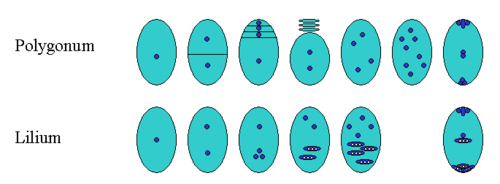
| Home | Sources Directory | News Releases | Calendar | Articles | | Contact | |
Ovule

Ovule literally means "small egg." In seed plants, the ovule is the structure that gives rise to and contains the female reproductive cells. It consists of three parts: The integuments forming its outer layer, the nucellus (or megasporangium), and the megaspore-derived female gametophyte (or megagametophyte) in its center. The megagametophyte (also called embryo sac in flowering plants) produces the egg cell for fertilization. After fertilization, the ovule develops into a seed.
Contents |
[edit] Location within the plant
In flowering plants, the ovule is located within the actual flower, the part of the carpel known as the ovary, which ultimately becomes the fruit. Depending on the plant, flowers may have one or multiple ovules per ovary. The ovules are attached to the placental wall of the ovary through a structure known as the funiculus, the plant equivalent of an umbilical cord. Different patterns of ovule attachment, or placentation, can be found among plants: In parietal placentation, the ovules are attached to the outer ovary wall, whereas in free central placentation, they are attached to a central column within the ovary. In axile placentation, they are attached to radial spokes within the ovary.
In gymnosperms such as conifers and similar plants, the ovules are borne unenclosed on the surface of an ovuliferous (ovule-bearing) scale, usually within an ovulate cone (also called megastrobilus).
[edit] Ovule parts and development
The ovule is composed of diploid maternal tissue that gives rise to the haploid tissue of the female gametophyte. The maternal tissues of the ovule include the integuments and the nucellus. The next "generation" formed within the ovule are the haploid megaspore and megagametophyte, or embryo sac. After fertilization of the egg cell and formation of a zygote, the ovule contains the embryo of the next sporophyte generation and, in flowering plants, the triploid endosperm.
[edit] Integuments, micropyle and chalaza
The integuments are the outer cell layers of the ovule enclosing the nucellus. Gymnosperms typically have one integument layer while angiosperms typically have two. The integuments develop into the seed coat when the ovule matures after fertilization.
The integuments do not enclose the nucellus completely but leave an opening at its apex referred to as the micropyle. The micropyle opening allows the pollen tube to enter the ovule for fertilization. In gymnosperms (e.g. conifers), the pollen itself is drawn into the ovule and the micropyle opening closes after pollination. During germination, the seedling's radicle emerges through the micropyle.
Located opposite from the micropyle is the chalaza where the nucellus is joined to the integuments. Nutrients from the plant travel through the phloem of the vascular system to the funiculus and outer integument and from there apoplastically and symplastically through the chalaza to the nucellus inside the ovule. In chalazogamous plants, the pollen tubes enter the ovule through the chalaza instead of the micropyle opening.
[edit] Nucellus, megaspore and perisperm
The nucellus (plural: nucelli) is the central portion of the ovule inside the integuments. It consists of diploid maternal tissue and has the function of a megasporangium. In immature ovules, it contains a megasporocyte (megaspore mother cell), which undergoes sporogenesis via meiosis. Three of the four haploid cells produced in meiosis degenerate, leaving one surviving megaspore inside the nucellus. After fertilization, the nucellus develops into the perisperm that feeds the embryo. In some plants, the diploid tissue of the nucellus can give rise to a seed through a mechanism of asexual reproduction called nucellar embryony.
[edit] Megagametophyte and embryo sac
The haploid megaspore inside the nucellus gives rise to the female gametophyte (megagametophyte). In gymnosperms, the female gametophyte consists of around 2000 nuclei and forms archegonia which produce the egg cells for fertilization. In flowering plants, the megagametophyte, also referred to as embryo sac, is much smaller and typically consists of only seven cells and eight nuclei. The embryo sac develops from the megaspore through three rounds of mitotic divisions. The cell closest to the micropyle opening of the integuments differentiates into the egg cell, with two synergid cells by its side that may be involved in the production of signals that guide the pollen tube. Three antipodal cells form on the opposite (chalazal) end of ovule and later degenerate, serving no obvious function. The large central cell of the embryo sac contains two polar nuclei.
[edit] Zygote, embryo and endosperm
The pollen tube releases two sperm nuclei into the ovule. In gymnosperms, fertilization occurs within the archegonia produced by the female gametophyte. While it is possible that several egg cells are present and fertilized, typically only one zygote will develop into a mature embryo as the resources within the seed are limited.
In flowering plants, one sperm nucleus fuses with the egg cell into a zygote, the other fuses with the two polar nuclei of the central cell to give rise to the triploid endosperm. This double fertilization is unique to flowering plants. The plant stores nutrients such as starch, proteins and oils in the endosperm as a food source for the developing embryo and seedling, serving a similar function to the yolk of animal eggs. The endosperm is also called the albumen of the seed.
[edit] References
- P.H. Raven, R.F. Evert, S.E. Eichhorn (2005): Biology of Plants, 7th Edition, W.H. Freeman and Company Publishers, New York, ISBN 0-7167-1007-2
[edit] See also
|
SOURCES.COM is an online portal and directory for journalists, news media, researchers and anyone seeking experts, spokespersons, and reliable information resources. Use SOURCES.COM to find experts, media contacts, news releases, background information, scientists, officials, speakers, newsmakers, spokespeople, talk show guests, story ideas, research studies, databases, universities, associations and NGOs, businesses, government spokespeople. Indexing and search applications by Ulli Diemer and Chris DeFreitas.
For information about being included in SOURCES as a expert or spokesperson see the FAQ . For partnerships, content and applications, and domain name opportunities contact us.


